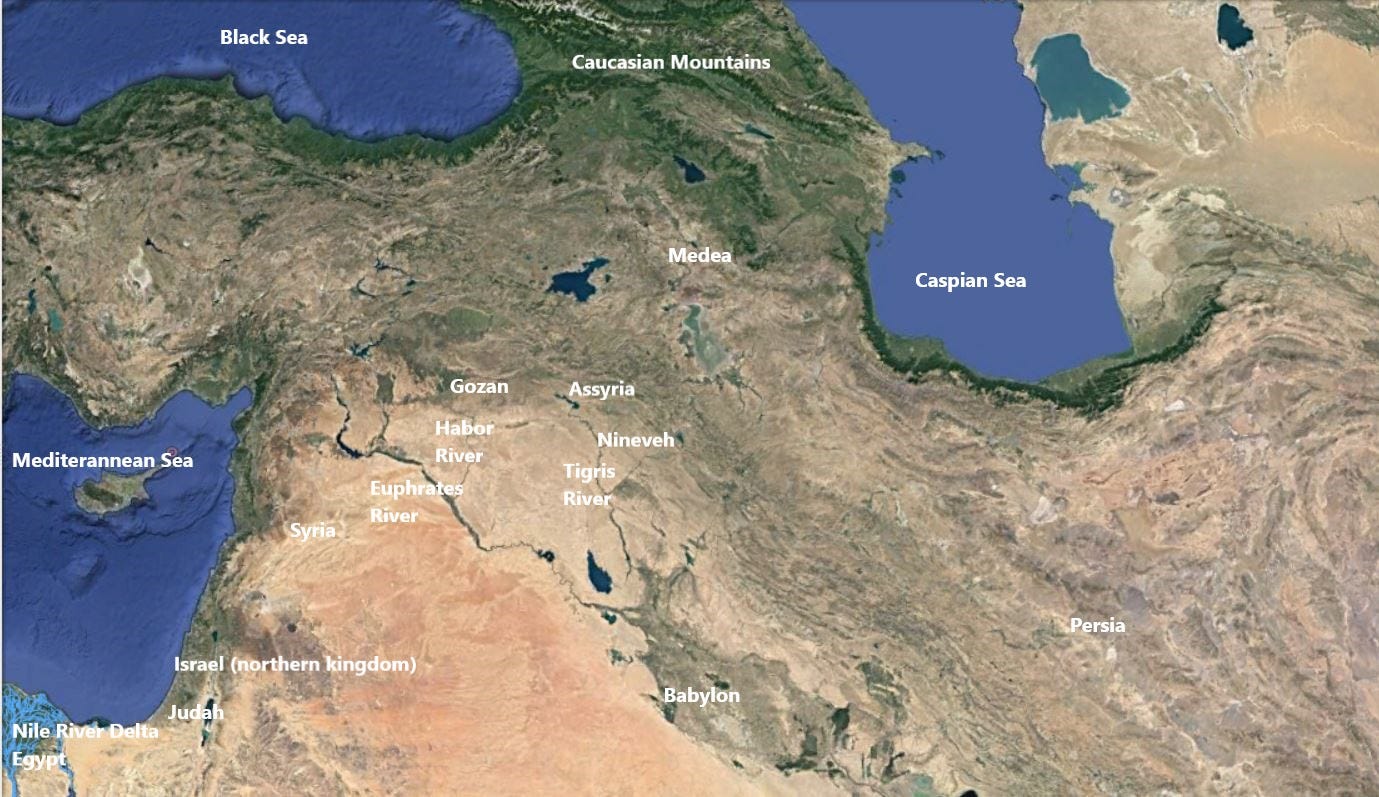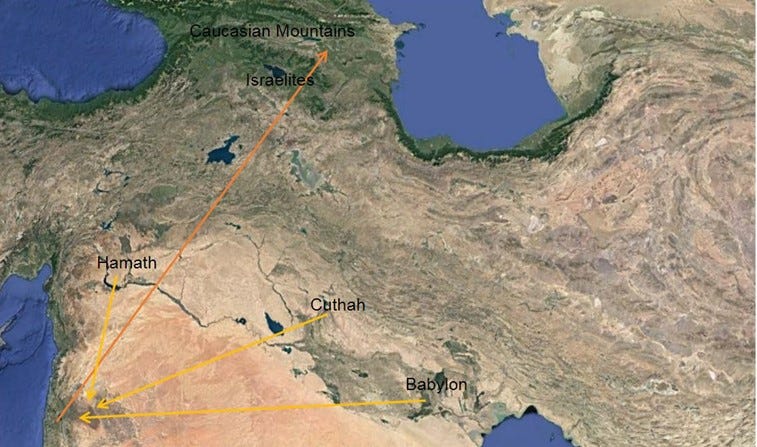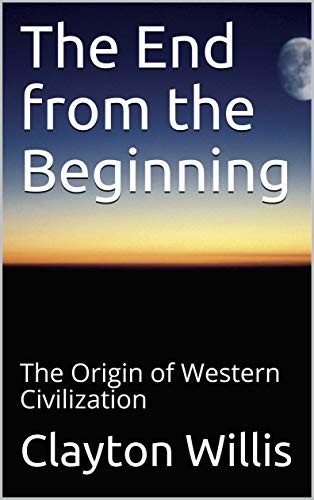The Lost Centuries
Distortion of history before and after the time of Jesus has a cost
Connecting Bible times to our time
Many people despise history. That’s one reason why many do not connect Bible times to our times1. This Substack Newsletter is part of my effort to make some rather obscure history more easily understood – to help us understand why it’s obscure and how it connects Bible times to our times.
Something that happened 3,000 years ago that is vital to understanding today
It is very difficult to understand the setting – the physical environment – of the information that follows. This graphic shows the Middle-East in the 700’s BC:

Near the bottom left corner is depicted the “promised land”, the homeland of the children of Israel.
The fall of Israel
In about 930 BC – just after the death of Solomon – the nation of Israel became two nations: the Kingdom of Israel (led by Jeroboam) and the Kingdom of Judah (led by Solomon’s son Rehoboam).
There were 18 kings of Israel after Jeroboam, each worse than the last, who led Israel deeper and deeper into idolatry and the worship of false gods like Baal and Molech with sacrifice of young children a common practice.
God sent dozens of prophets to call the Israelites back to Him – Elijah perhaps the best known – but the Israelites would not listen. Even with the curses brought on by disobedience promised by God at Mt. Sinai [Deuteronomy 28:15–68] reiterated by the prophets, they would not listen.
Among those punishments was the withholding of God’s physical blessings promised in Abraham’s covenant for 2,540 years2.
More immediate was the promise of long-term captivity before they would return to God.
Israel goes into captivity
In 721 BC, thousands of Israelites from the northern kingdom, the Kingdom of Israel, were captured and dispersed by the armies of the Assyrian Empire into eastern Syria, the upper parts of Mesopotamia and into “the cities of the Medes”3

The long orange line shows the deportation path along which the Assyrian Empire moved the captured Israelites with most being moved to Medea.
The three yellow lines show where their replacements were moved from to the land formerly occupied by the Israelites. These people, in the time of Jesus, were called Samaritans. This transaction at least partially explains why the Jews of Jesus’ day hated the Samaritans.4
5 Now the king of Assyria went throughout all the land, and went up to Samaria and besieged it for three years. 6 In the ninth year of Hoshea, the king of Assyria took Samaria and carried Israel away to Assyria, and placed them in Halah and by the Habor, the River of Gozan, and in the cities of the Medes. 2 Kings 17:5–6 (NKJV)
24 Then the king of Assyria brought people from Babylon, Cuthah, Ava, Hamath, and from Sepharvaim, and placed them in the cities of Samaria instead of the children of Israel; and they took possession of Samaria and dwelt in its cities.[i] 2 Kings 17:24 (NKJV)
To orient the events in this newsletter, this graphic shows the same area today:

These deported Israelites are those often referred to as the “lost 10 tribes” of Israel.
800 years of Israel’s lost history
There is no reliable secular history that mentions the 10 tribes for the next 800 years; mentions in Biblical history are quite sparse but are intriguing because of their mention of Israelites in the Persian Empire.
This passage from Daniel, who resided at times in Ecbatana, the capital of Medea during the reign of Darius, King of Persia (who was a Mede)5.
7 O Lord, righteousness belongs to You, but to us shame of face, as it is this day—to the men of Judah, to the inhabitants of Jerusalem and all Israel, those near and those far off in all the countries to which You have driven them, because of the unfaithfulness which they have committed against You. Daniel 9:7 (NKJV)
Daniel’s time was during the Jewish exile to Babylon. Most Jews were required to remain in Babylon until the Medo-Persian Empire conquered Babylon. Yet Daniel mentions “all Israel” “far off in all the countries to which You have driven them”. Daniel obviously knew that there were Israelites other than Jews who were in captivity.
It is likely that the presence of Israelites in the Persian Empire as recorded in the book of Esther included the 10 tribes as well as the Jews. The book of Esther was likely written in about 300 BC according to scholars. The story takes place during the reign of King Ahasuerus (Xerxes II) of Persia not long before Alexander the Great conquered Persia.
This passage is quite intriguing! This is 200 years after most of the Jews had been allowed to return to Palestine and complete the rebuilding of the temple in Jerusalem in 516 BC. Yet the people “scattered and dispersed” “in all the provinces” of the Persian kingdom are cited.
8 Then Haman said to King Ahasuerus, “There is a certain people scattered and dispersed among the people in all the provinces of your kingdom; their laws are different from all other people’s, and they do not keep the king’s laws. Therefore it is not fitting for the king to let them remain.” Esther 3:8 (NKJV)
Because of the propensity of historians and translators to call all Israelites “Jews”,6 it’s likely that this story was about some Jews and the people of the 10 tribes – who were dispersed among all the provinces of the Persian Empire.
For the next 800 years, except for these enigmatic scriptures, no secular or Biblical historian directly mentions the fate of those tens of thousands of Israelites deported to Medea.
In that 800 years, recorded and reliable history shows that those living in the middle East experienced:
Ø the fall of the Assyrian Empire (612 BC)
Ø the rise and fall of the Medean Empire (559 BC)
Ø the rise and fall of the Babylonian Empire (539 BC)
Ø the rise and fall of the Medo-Persian Empire (330 BC)
Ø the rise and fall of the Macedonian/Greek Empire (250 BC)
Ø the rise of the Parthian Empire in the middle East (250 BC – 225 AD)
Ø the rise of the Roman Empire in southern Europe and most of the countries bordering the Mediterranean Ocean (27 BC).
The next reliable mention of the 10 tribes – Josephus
The next trusted geographical/historical mention of the location of the 10 tribes comes from Flavius Josephus’ Antiquities of the Jews. Josephus, writing in 94 AD, places them in Mesopotamia – specifically “beyond the Euphrates”.
So, he read the epistle at Babylon to those Jews that were there; but he kept the epistle itself, and sent a copy of it to all those of his own nation that were in Media. And when these Jews had understood what piety the king had towards God, and what kindness he had for Esdras they were all greatly pleased; nay, many of them took their effects with them, and came to Babylon, as very desirous of going down to Jerusalem; but then the entire body of the people of Israel remained in that country; wherefore there are but two tribes in Asia and Europe subject to the Romans, while the ten tribes are beyond Euphrates till now, and are an immense multitude, and not to be estimated by numbers7.
Esdras was Josephus’ name for Ezra, to whom one of the books of the Old Testament is attributed and one of the Jewish leaders of the Jews’ return to Palestine.
Many of the Jews left and went back to Palestine around 540 B.C.; the Israelites – descendants of the “10 lost tribes” – remained “beyond the Euphrates”.
The phrase “the ten tribes are beyond Euphrates till now” verifies the location of the 10 tribes as being in the Parthian Empire in the first century AD. Josephus published Antiquities in approximately 94 A.D8.
Beyond the Euphrates would have included the modern regions of Azerbaijan, Armenia, Georgia, Kurdistan, Iran, Iraq, eastern Pakistan and Eastern Turkey – all controlled in the 1st Century AD by the Parthian Empire. When the Jews of Medea left for Babylon to join the Jewish exiles returning to Palestine, the Israelites of the 10 tribes remained in that area, which was not subject to Roman rule in the first century A.D.
Josephus gives us three pieces of important information:
1. the 10 tribes were still recognizable; they had not been fully integrated with the gentile Medes and Persians.
2. they were clustered in one large area “beyond the Euphrates” i.e., in the Parthian Empire in the first century A.D.
3. their numbers were immense, so immense that their numbers could not be estimated.
Josephus was a first-rate historian with his history of the 1st century AD respected by most of today’s historians even if they question his history of prior times. We can rely on his statement that the 10 tribes were clustered in the Parthian Empire, that they were still distinguishable in 94 AD, and their numbers were immense.
How many Israelites lived in the Parthian Empire? There is no historical record but suggesting that after 8 centuries living in that area, hundreds of thousands would not be unreasonable.
Why is this important?
Ø There are many Bible prophecies concerning the reconciliation of the 10 lost tribes with God; they were reconciled with God by accepting Jesus as the Messiah.
Ø Jesus sent His apostles to “the lost sheep of the House of Israel” [Matthew 10:1–23]. Historians and contemporary, credible researchers show several and perhaps all of the apostles other then James, John and Paul went to the Parthian Empire in the 1st Century AD – some before 40 AD.
Ø The New Covenant was to be made with the House of Israel and the House of Judah. The House of Judah was primarily in Palestine; the House of Israel was primarily in the Parthian Empire.
Ø The conversion of hundreds of thousands in the Parthian Empire explains the exponential growth of the church in the first 3 centuries AD.
The 800-year history of the 10-tribed Israelites (not Jews) has been lost or obscured; also, their conversion to Christianity in the 300 years after the advent of the Christ is lost or obscured – only mentioned peripherally by historians.
The history of the early church has also been lost or obscured
Likewise, the history of the early church has also been obscured by the rise of the hierarchy in the church which led to the Catholic hierarchies of today. Once this hierarchy obtained power, one of their first objectives was to eliminate all connections with the Jews.
However, another objective of the hierarchy was to connect themselves to the apostles (who were Jews) and to claim their power over the church was handed down to them by those Jewish apostles.
The hierarchy that developed in the church in the 2nd century AD began to obscure many of the original teachings of Jesus and His apostles. They began composing a false history to connect the hierarchy to the apostles to support their claim to power over the church.
Over the next few centuries, the hierarchy added “priests” to the Biblical “offices” of the church. They insured the separation of the church from the Jews by changing the traditional day of assembly from the Sabbath to Sunday and incorporating pagan holidays.
By the 500’s AD, they set up the international authority of the “holy father”, the Pope and began incorporating political power into that hierarchy.
The hierarchy produced a long history of evils such as the Inquisition and the perversion of the priesthood due to the unnatural and un-Biblical demand for celibacy among Catholic priests.
The history of the Catholic Church, though distorted, is well known but the history of the Israelites converted to Christianity in the Parthian Empire remains obscure.
Relatively new historical research helps fill in the gaps
Fortunately some Biblical historians and researchers have inadvertently9 shed a great light on what truly happened to those Parthian Israelites.
In an October 16th Substack Newsletter titled “What happened to the other apostles?” I elaborated upon the work of William Steuart McBirnie in 1973 called “The Search for the Twelve Apostles”10.
Those spirit-filled apostles began arriving in the Parthian Empire before 40 AD. Just imagine the effect of preaching by eye-witnesses of the work and teaching of Jesus coupled with the ability to heal and even raise from the dead [Matthew 10:7–8].
Provinces of the Parthian Empire were the first government on earth to declare Christianity the state religion – long before the Romans did so in the 300’s AD. Even secular histories of the Parthian Empire notice their rapid acceptance of Christianity and other reliable historians like George Rawlinson affirm that scenario.
Quote from The History of Parthian Empire:
Christianity also penetrated the Parthian provinces to a considerable extent, and in one Parthian country, at any rate, seems to have become the state religion. The kings of Osrhoene are thought to have been Christians from the time of the Antonines, if not from that of our Lord; and a nourishing church was certainly established at Edessa before the end of the second century.
The Parthian Jews who were witnesses of the miraculous events which signalized the day of Pentecost may have, in some cases, taken with them the new religion to the land where they had their residence; or the Apostle, St. Thomas, may (as Eusebius declares) have carried the Gospel into the regions beyond the Euphrates, and have planted the Christian Church in the countries out of which the Jewish Church sprang. Besides the nourishing community of Edessa, which was predominantly, if not wholly, Christian from the middle of the second century, many converts were, we are told, to be found among the inhabitants of Persia, Media, Parthia Proper, and even Bactria.
The social turmoil inherent in the Roman Empire – they relentlessly persecuted Christians for 300 years – coupled with the natural bias of the Greek and Roman historians – produced the three “Lost Centuries”: the last 40 years of the 1st and the entire 2nd and most of the 3rd Centuries AD in which there was little reliable history recorded.
Consequences of the lost centuries
The consequence of the lost centuries is that virtually no one – Biblical and secular historians and Bible teachers alike – makes the connection between those Parthian Christians, the exponential growth of the early church and the rest of history down to our times.
Those first century converts and their descendants and those they taught and converted to Christianity not only were responsible for the exponential growth of God’s church in the first three centuries AD but later helped form Western Civilization.
It is Western Civilization that not only received the blessings from Abraham’s Covenant and founded Great Britain and the United States and the other nations of Western Civilization but also which has been responsible for truly spreading the gospel of Jesus and the physical blessings of Abraham’s Covenant to the whole world just as God promised would happen.
Further consequences of the lack of historical knowledge
After a run of 300+ years, Western Civilization is tottering on the brink of disintegration or transformation into an oppressive, socialist catastrophe.
But, we’ve had a long run of mostly good times and the advancement of freedom, medicine, science, agriculture, manufacturing techniques, the rule of law and prosperity.
As history like what I’ve showed you proves, God does not prevent nations He caused to be established from destroying themselves.
HOWEVER, if God’s people will turn to Him, get their lives in order, love their neighbors as themselves and work to make things better, He will supply forgiveness and the blessings for them to recover what they have lost or almost lost.
For the sake of my children, my grandchildren and their descendants, I pray that will happen. SOON!

